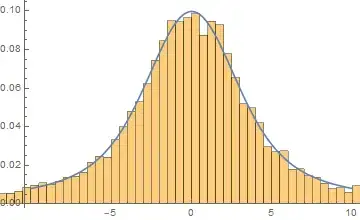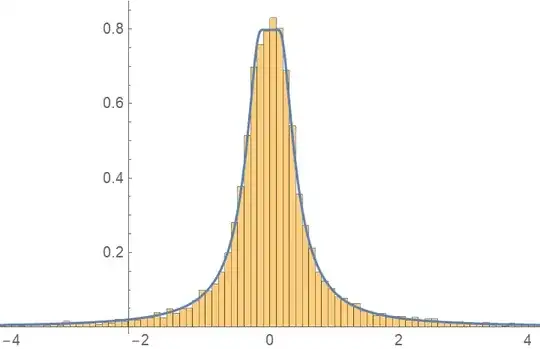This gives two answers but not the algebraic steps to prove it. Using Mathematica one can find the density for the ratio $N/U$:
d = TransformedDistribution[z/u, {z \[Distributed] NormalDistribution[0, b],
u \[Distributed] UniformDistribution[{-a, a}]}];
PDF[d, r]
$$\frac{b \left(1-e^{-\frac{a^2 r^2}{2 b^2}}\right)}{\sqrt{2 \pi } a r^2}$$
For the density at $r=0$, one could take the limit of the above function as $r \rightarrow 0$:
Limit[PDF[d, r], r -> 0]
$$\frac{a}{2 \sqrt{2 \pi } b}$$
As a check one could perform some simulations:
n = 10000;
zz = RandomVariate[NormalDistribution[0, 1], n];
uu = RandomVariate[UniformDistribution[{-1/2, 1/2}], n];
rr = zz/uu;]
density = PDF[d /. {a -> 1/2, b -> 1}, r];
Show[Histogram[rr, {0.5}, "PDF", PlotRange -> {{-10, 10}, All}],
Plot[density, {r, -10, 10}]]

For the ratio $U/N$ one can find the density as follows:
d = TransformedDistribution[u/z, {z \[Distributed] NormalDistribution[0, b],
u \[Distributed] UniformDistribution[{-a, a}]}];
PDF[d, r]
$$\begin{array}{cc}
\{ &
\begin{array}{cc}
\frac{b}{\sqrt{2 \pi } a} & r=0 \\
\frac{b \left(1-e^{-\frac{a^2}{2 b^2 r^2}}\right)}{\sqrt{2 \pi } a} & r \neq 0 \\
\end{array}
\\
\end{array}$$
Here, too, simulations help:
n = 10000;
zz = RandomVariate[NormalDistribution[0, 1], n];
uu = RandomVariate[UniformDistribution[{-1/2, 1/2}], n];
rr = uu/zz;
density = PDF[d, r] /. {a -> 1/2, b -> 1};
Show[Histogram[rr, {0.1}, "PDF"],
Plot[density, {r, -5, 5}, PlotRange -> {{-4, 4}, All}],
PlotRange -> {{-4, 4}, All}]


